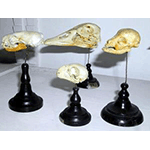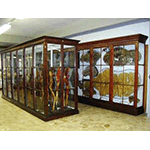Università degli Studi di Pisa - Dipartimento di Anatomia, Biochimica e Fisiologia Veterinaria - Museo Anatomico Veterinario [University of Pisa - Department of Veterinary Anatomy, Biochemistry and Physiology - Veterinary Anatomical Museum]
The first information on the teaching of veterinary science at Pisa dates from 1818, the year in which Vincenzo Mazza, veterinary of Napoleon’s grand armée, opened a small school under the protection of Prince Canosa. But it was only in 1839 that the first true Chair of Veterinary Science was instituted, at the time annexed to the Pisa Faculty of Medicine and directed by Felice Melchiorre Tonelli. In 1859 the Chair moved to the Agronomy-Veterinarian Section of the Faculty of Physical and Mathematical Sciences, until, due to a constant increase in the number of students, the Higher School of Veterinary Science was detached from the University and became, in 1923, the Royal Higher Institute of Veterinary Science. Its independence came to an end, however, a few years later, in 1934, when the institution was transformed into the Faculty of Veterinary Science, returning definitively to form part of the University of Pisa. In 1990 the Institutes merged to form the Department of Anatomical, Physiological and Animal Production Sciences, from which in 1995 the present-day Department of Veterinary Anatomy, Biochemistry and Physiology was detached.
The history of the Museum runs parallel to these events. In 1874, Prof. Luigi Lombardini decided, in fact, to designate a room in the Anatomy Cabinet to the collection and exhibition of the anatomical preparations used up to then for educational purposes, thus creating the first nucleus of the museum. Incremented through the contributions of students and professors, in 1965 the Veterinary Anatomy Museum moved, along with the Faculty, to its new location in Via delle Piagge, and is today incorporated in the Department of Veterinary Anatomy, Biochemistry and Physiology. It possesses a collection of veterinary anatomical preparations from every species of domesticated mammal, dating from the middle of the 19th century to the present: skeletons and joints, mummified parts taken from the dissection of the head-neck-chest assembly, individual organs conserved in formalin, hollow organs, inflated and dried, from the digestive, respiratory and urogenital tracts, male and female genital organs, foetuses and placentas.
****************************
Texts by Elena Fani
English translation by Catherine Frost
Last update 05/feb/2008





